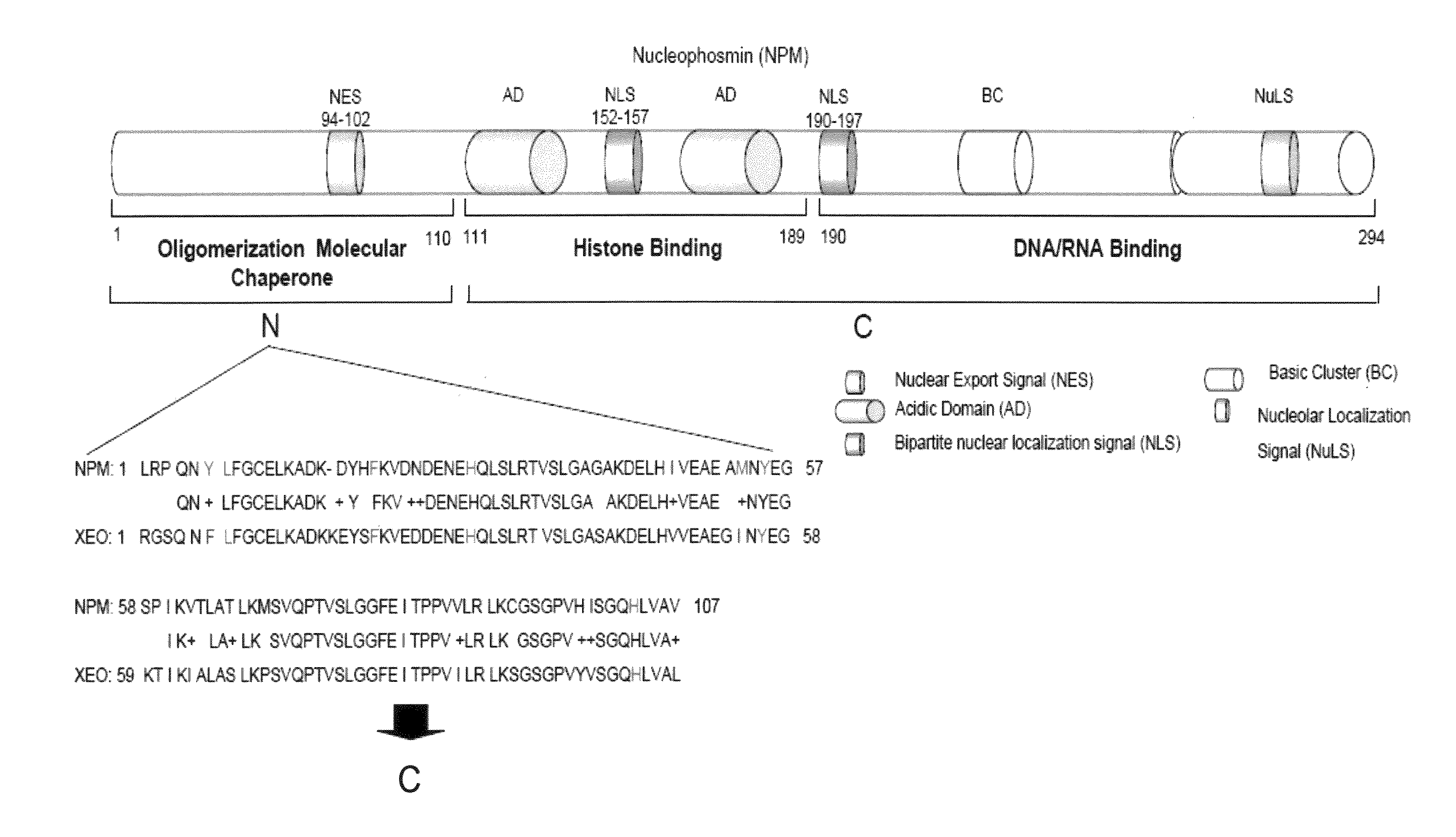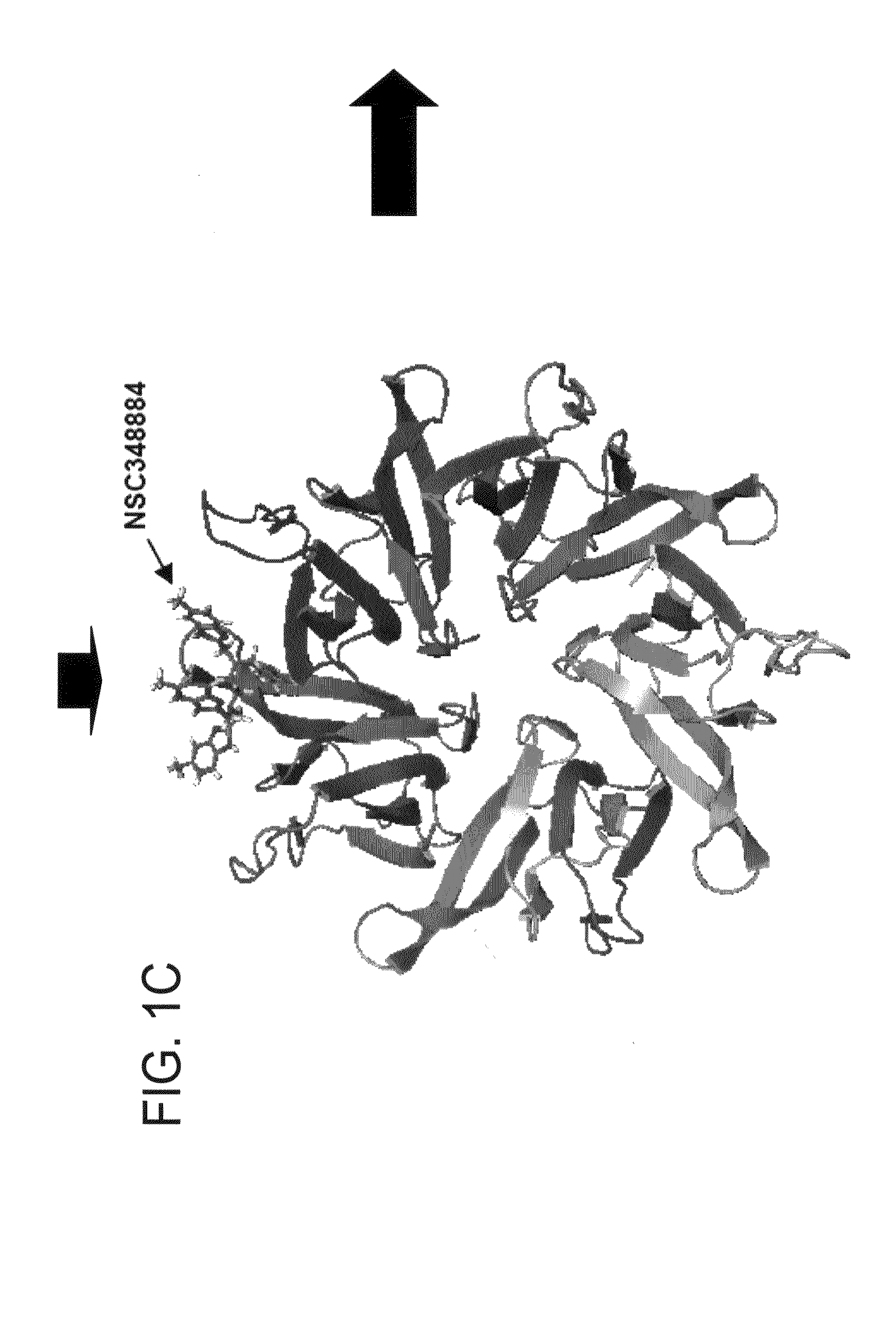Inhibitors of nucleophosmin (NPM) and methods for inducing apoptosis
- Summary
- Abstract
- Description
- Claims
- Application Information
AI Technical Summary
Benefits of technology
Problems solved by technology
Method used
Image
Examples
example 1
Structure-Based Discovery of Small Molecular Inhibitors of NPM
[0094]NPM forms dimers and higher oligomers via its N-terminal globular domain (residues 1-110) (FIG. 1A, Hingorani et al., 2000). The inventors sought out a small molecular inhibitor (SMI), targeting protein-protein interactions of the dimer interface that would inhibit NPM function. Since there is no crystal structure available for human NPM, a homology model of human NPM was built according to the Xenopus NO38-core chaperone structure (residues 1-107) (pdb:1XE0) (Namboodiri et al., 2004), which has a sequence identity of 77% and similarity of >90%. The homology model of NPM demonstrated a highly conserved topology and side-chain interactions of the dimer interface in comparison to Xenopus NO38-core structure. Inspection of the subunit interface revealed a predominantly hydrophobic-aromatic interaction that promotes the formation of a dimer and pentamer. Residues Tyr6, Lue7, Phe20, His29, Met53, Tyr55 and His104 are int...
example 2
NSC348884 Disrupts NPM Oligomer Formation
[0095]To examine whether NSC348884 specifically interacts with NPM and disrupts its oligomer formation, LNCaP and HCT116 cells with wild type NPM (no translocations) were treated with varying concentrations of NSC348884 (0, 5, 6 μM) for 24 hr, lyzed under non-denaturing conditions and analyzed by native PAGE which is an excellent tool for detecting oligomers and aggregates since the protein retains its folded conformation. We utilized 14-3-3 which forms dimers as a control. FIG. 2 shows that in both LNCaP and HCT116 cells, the NPM oligomer is disrupted with the formation of NPM monomers (FIG. 2A, FIG. 2C and FIG. 2E) at 5 and 6M NSC348884, with no effect on the 14-3-3 dimer formation (Mr ˜60 kDa) (FIG. 2B) in these cells. The two bands shown in HCT116 represent different isoforms of 14-3-3 proteins. Taken together, NSC348884 is able to bind to NPM and interfere with oligomer formation of NPM specifically.
example 3
Inhibition of NPM is Cytotoxic and Synergizes with Doxorubicin
[0096]NPM plays an essential role in cellular activities such as ribosome biogenesis, cell proliferation, apoptosis and centrosome duplication. Therefore, inhibition of NPM should affect cell growth. To determine the effect of NPM inhibitor NSC348884 on cancer cell proliferation, cell viability assays were conducted on LNCaP and Granta (human mantle cell lymphoma) cells (Granta-519, -4, -22) with varying concentrations of NSC348884 over 4 days. In LNCaP cells the IC50 for cell viability was ˜4 μM (FIG. 3A), while for the 3 Granta cell lines the IC50 was ˜1.7 μM (FIG. 3A). The difference in IC50 is attributed to the differential proliferative capacity of the two types of cancer cell lines. Since Rev peptide binds to NPM and potentates the doxorubicin-induced decrease of cellular viability and inhibition of tumor growth in nude mice (Chan et al., 2005), we evaluated if NSC348884 would be additive or synergistic with doxorub...
PUM
| Property | Measurement | Unit |
|---|---|---|
| Mass | aaaaa | aaaaa |
| Biological properties | aaaaa | aaaaa |
| Pharmaceutically acceptable | aaaaa | aaaaa |
Abstract
Description
Claims
Application Information
 Login to View More
Login to View More - R&D
- Intellectual Property
- Life Sciences
- Materials
- Tech Scout
- Unparalleled Data Quality
- Higher Quality Content
- 60% Fewer Hallucinations
Browse by: Latest US Patents, China's latest patents, Technical Efficacy Thesaurus, Application Domain, Technology Topic, Popular Technical Reports.
© 2025 PatSnap. All rights reserved.Legal|Privacy policy|Modern Slavery Act Transparency Statement|Sitemap|About US| Contact US: help@patsnap.com



